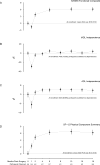Association Between Hospital Readmission and Acute and Sustained Delays in Functional Recovery During 18 Months After Elective Surgery: The Successful Aging after Elective Surgery Study
- PMID: 27898172
- PMCID: PMC5258816
- DOI: 10.1111/jgs.14549
Association Between Hospital Readmission and Acute and Sustained Delays in Functional Recovery During 18 Months After Elective Surgery: The Successful Aging after Elective Surgery Study
Abstract
Objectives: To examine the effect of hospital readmission on functional recovery after elective surgery in older adults.
Design: Prospective cohort of individuals aged 70 and older undergoing elective surgery, enrolled from June 2010 to August 2013.
Setting: Two academic medical centers.
Participants: Community-dwelling older adults (N = 566; mean age ± standard deviation 77 ± 5) undergoing major elective surgery and expected to be admitted for at least 3 days.
Measurements: Readmission was assessed in multiple interviews with participants and family members over 18 months and validated against medical record review. Physical function was assessed according to ability to perform instrumental activities of daily living (IADLs) and activities of daily living (ADL), Medical Outcomes Study 12-item Short-Form Survey Physical Component Summary score, and a standardized functional composite.
Results: Two hundred fifty-five (45%) participants experienced 503 readmissions. Readmissions were associated with delays in functional recovery in all measures of physical function. Having two or more readmissions over 18 months was associated with persistent and significantly greater risk of IADL dependence (relative risk (RR) = 1.8, 95% confidence interval (CI) = 1.5-2.3) and ADL dependence (RR = 3.3, 95% CI = 1.7-6.4). Degree of functional impairment increased progressively with number of readmissions. Readmissions within 2 months resulted in delayed functional recovery to baseline by 18 months, and readmissions between 12 and 18 months after surgery resulted in loss of functional recovery previously achieved.
Conclusion: Readmission after elective surgery may contribute to delays in functional recovery and persistent functional deficits in older adults.
Keywords: aging; cohort study; physical function; readmission; surgery.
© 2016, Copyright the Authors Journal compilation © 2016, The American Geriatrics Society.
Figures



References
-
- Metter EJ, Schrager M, Ferrucci L, et al. Evaluation of movement speed and reaction time as predictors of all-cause mortality in men. J Gerontol A Biol Sci Med Sci. 2005;60:840–846. - PubMed
-
- Onder G, Penninx BWJH, Ferrucci L, et al. Measures of physical performance and risk for progressive and catastrophic disability: results from the Women’s Health and Aging Study. J Gerontol A Biol Sci Med Sci. 2005;60:74–79. - PubMed
Publication types
MeSH terms
Grants and funding
LinkOut - more resources
Full Text Sources
Other Literature Sources

